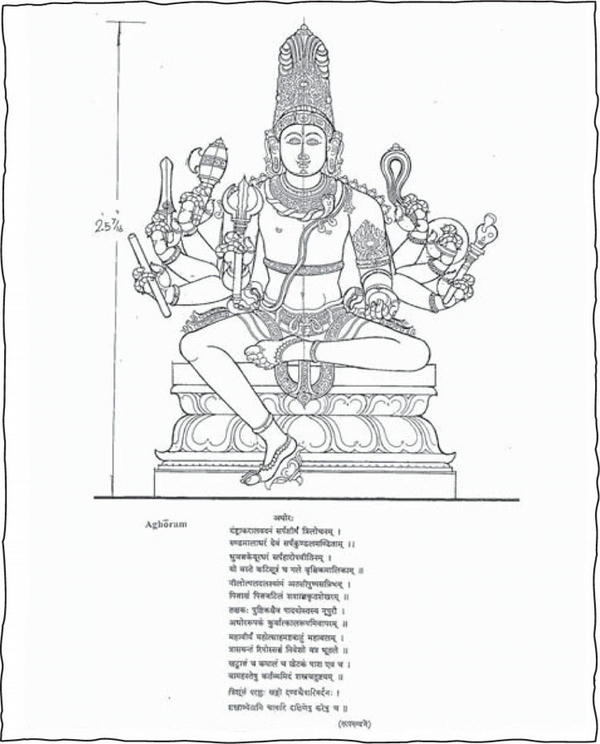2. The Iraivan Panchabrahma
Circumambulation Sadhana
Walk clockwise around the Iraivan sanctum offering a simple chant to each bronze murti of one of the aspects of Panchabrahma, also called Sadasiva. §
Left front is Tatpurusha. Chant “Aum Sri Tatpurushaya Namaha” three or more times while holding in mind the specific function of that aspect of Śiva. Then move to the next bronze shrine.§
Left back is Aghora. Chant “Aum Sri Aghoraya Namaha” three or more times while holding in mind the specific function of that aspect of Śiva. Then move to the next bronze shrine.§
Backside is Sadyojata. Chant “Aum Sri Sadyojataya Namaha” three or more times while holding in mind the specific function of that aspect of Śiva. Then move to the next bronze shrine.§
Right back is Vamadeva. Chant “Aum Sri Vamadevaya Namaha” three or more times while holding in mind the specific function of that aspect of Śiva. Then move to the next bronze shrine.§

Right front is Iśana. Chant “Aum Sri Iśanaya Namaha” three or more times while holding in mind the specific function of that aspect of Śiva. Then move in front of the main sanctum.§
The main sanctum represents all five aspects of Panchabrahma. Chant “Aum Sri Sadaśivaya Namaha” three or more times while holding in mind all five functions of Sadaśiva.§
Repeat the entire process at least three times.§
Quote from Gurudeva§
God Śiva is all and in all, one without a second, the Supreme Being and only Absolute Reality. He is Pati, our Lord, immanent and transcendent. To create, preserve, destroy, conceal and reveal are His five powers. Aum.§
Supplementary Reading§
Saiva Siddhanta is the formalized theology of the divine revelations contained in the twenty-eight Saiva Agamas. In the Saiva Siddhanta tradition God Śiva is the Supreme Being who as the Lord of the Universe Himself performs the actions of creation, preservation, and destruction. This, of course, is a totally different approach than the well known trinity approach found in the Puranas, the folk narratives containing ethical and cosmological teachings relative to Gods, man and the world. The Puranas definitely do present a concept of Hinduism as a religion with a trinity of Gods: Brahmā the Creator, Vishnu the Preserver and Rudra (Śiva) as the Destroyer. However, in Saiva Siddhanta these cosmic actions are all performed by God Śiva. §


In addition to the three actions, God Śiva also performs two more actions, which relate specifically to the soul. The fourth action is His concealing grace which limits consciousness, allowing souls to mature through experience. And the fifth action is His revealing grace by which the soul ultimately transcends its bondage and realizes its identity with Him. Here are two verses from the Raurava Agama describing these five actions of God Śiva: §
“The birth of the world, its maintenance, its destruction, the soul’s obscuration and liberation are the five acts of His dance.” §
“Paramesvara (Śiva) is the cause of the five manifest aspects: emanation, srishti; preservation, sthiti; dissolution, samhara; concealment, tirobhava; and revelation, anugraha.”§
There is a form of God Śiva that is widely known which depicts these five actions. It is Śiva as the Lord of dance or Nataraja. In this murti the symbolism for all five actions is clearly present. Srishti: creation, or emanation, is represented by His upper right hand and the damaru, the drum, upon which he beats Paranada, the Primal Sound from which issue forth the rhythms and cycles of creation. Sthiti: preservation, is represented by His lower right hand in a gesture of blessing, abhaya mudra, saying “fear not;” Samhara: destruction, dissolution or absorption, is represented by the fire in His upper left hand, posed in ardhachandra mudra, “half-moon gesture;” Tirobhava: obscuring grace, the power which hides the truth, thereby permitting experience, growth and eventual fulfillment of destiny, is represented by His right foot upon the prostrate person, Apasmarapurusha, the principle of ignorance, or anava. Anugraha: revealing grace—which grants knowledge and severs the soul’s bonds—is represented by Śiva’s raised left foot, and by His lower left hand, held in gajahasta or “elephant trunk” mudra, inviting approach. §

Less well know to the general public, but quite well know to the Saivite priesthood and others who are knowledgeable about temple worship is another form of God Śiva performing these five actions. It is a form of Śiva that has five faces and is called the Sadasivamurti. In Sanskrit the five faces are referred to as Panchānana. In Tamil the five faces are referred to as Sivaperumanai Aindu Tirumukamkal which translates as “The Five Holy Faces of God Śiva”. §
In temple ceremonies based on the Saiva Agamas, there is a specific mantra used for each face. The mantras are Iśana, Tatpurusha, Aghora, Vamadeva and Sadyojata. The relationship between these mantras, the five divine powers and the five alternate names for these powers is in the chart below.§

In temple ceremonies based on the Saiva Agamas, it is this five-fold form of Śiva that is being worshipped in the Śiva lingam. To show this, some temples include in their decorations a metal covering over the Śiva lingam which has the five faces engraved in it. The fifth face of Isana can be placed on the top, but more commonly is left out. The Isana form is implied whether the fifth head is shown or not. Some Śiva lingas even have the faces carved into the linga itself. §

Additional Resources §
Panchabrahma article§